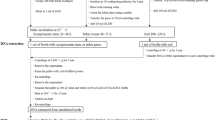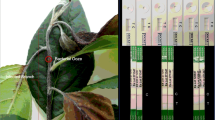Abstract
Automated conductance measurements in polypectate medium were used for the detection of pathogenic soft rot Erwinia spp. in potato peel extracts. The detection threshold for Erwinia carotovora subsp. atroseptica (Eca) in inoculated peel extracts was ca. 104 colony forming units (cfu) ml-1 when samples were considered positive on the basis of a response within 48 h at 20 °C. Detection of E. chrysanthemi (Ech) was less sensitive, only 105 cfu ml-1 peel extract were detected within 36 h at 25 °C. The linear correlation between detection times in conductimetry and inoculum levels of Eca and Ech in peel extracts was used for a quantitative estimation of Eca and Ech in naturally contaminated peel extracts. Samples giving a positive conductimetric response had to be confirmed with an enzyme-linked immunosorbent assay (ELISA) or polymerase chain reaction (PCR) for the presence of Eca and Ech, because E. carotovora subsp. carotovora (Ecc) also generated a conductance response. Conductimetry was sensitive and efficient for detection of contamination levels of Eca higher than 104 cfu ml-1 peel extract. For Ech, conductimetric detection was less sensitive and inefficient due to low contamination levels of Ech and the presence of high numbers of Ecc in many samples after enrichment, which interfered with the test. Immunofluorescence cell staining (IF) combined with enrichment and immunofluorescence colony staining (IFC) were suited to detect and quantify low numbers of Eca and Ech at less than 104 cfu ml-1 in peel extracts. However, since false positive and negative reactions in serology were observed, the use of PCR after enrichment, or in combination with IFC to confirm positive results, was required for accurate detection.
Similar content being viewed by others
References
Allan E and Kelman A (1977) Immunofluorescent stain procedures for detection and identification of Erwinia carotovora var. atroseptica. Phytopatology 67: 1305-1312
Bain RA, Pérombelon MCM, Tsror L and Nachmias A (1990) Blackleg development and tuber yield in relation to numbers of Erwinia carotovora subsp. atroseptica on seed potatoes. Plant Pathol 39: 125-133
Bolton FJ (1990) Conductance and impedance methods for detecting pathogens. In: Vaheri A, Tilton RC and Balows A (eds) Rapid Methods and Automation in Microbiology and Immunology (pp. 176-182) Springer Verlag, Berlin
Burr TJ and Schroth MN (1977) Occurrence of soft rot Erwinia spp. in soil and plant material. Phytopathology 67: 1382-1387
Cady P, Hardy D, Martins S, Dufour SW and Kraeger SJ (1978) Automated impedance measurements for rapid screening of milk microbial content. J Food Prot 41: 277-283
Capell CJ, Kirby RM and Moss MO (1995) A method and medium for the electrical detection of Listeria spp. from food. Int J Food Microbiol 25: 169-177
De Boer SH, Verdonck L, Vruggink H, Harju P, Bång HO and De Ley J (1987) Serological and biochemical variation among potato strains of Erwinia carotovora subsp. atroseptica and their taxonomic relationship to other E. carotovora strains. J Appl Bacteriol 63: 487-495
De Boer SH (1994) Prospects for control of potato diseases caused by pectolytic erwinias. In: Zehnder GW, Powelson ML, Jansson RK and Raman KV (eds) Advances in Potato Pest Biology and Management (pp. 136-148) APS press, St. Paul, Minnesota
De Boer SH and Ward LJ (1995) PCR detection of Erwinia carotovora subsp. atroseptica associated with potato tissue. Phytopathology 85: 854-858
De Boer SH, Ward LJ, LiXand Chittaranjan S (1995) Attenuation of PCR inhibition in the presence of plant compounds by addition of BLOTTO. Nuc Acids Res 23: 2567-2568
De Boer SH, Slack SA, Van den Bovenkamp GW and Mastenbroek I (1996) A role for pathogen indexing procedures in potato certification. In: Andrews JH, De Boer SH and Tommerup IC (eds) Pathogen Indexing Technologies, Advances in Botanical Research. Vol 23 (pp. 217-242) Academic Press, London
De Vries PM (1990) Stengelnatrot symptomen in aardappelplanten. Aardappelwereld 4: 15-18
Düring K, Porsch P, Fladung M and Lörz H(1993) Transgenic potato plants to the phytopathogenic bacterium Erwinia carotovora. The Plant J 3: 587-598
Fraaije BA, Birnbaum Y, Franken AAJM and Van den Bulk RW (1996) The development of a conductimetric assay for automated detection of metabolically active soft rot Erwinia spp. in potato tuber peel extracts. J Appl Bacteriol 81: 375-382 (in press)
Gorris MT, Alarcon B, Lopez MM and Cambra M(1994) Characterization Of monoclonal antibodies specific for Erwinia carotovora subsp. atroseptica and comparison of serological methods for its sensitive detection on potato tubers. Appl Environ Microbiol 60: 2076-2085
Hardy D, Kraeger SJ, Dufour SW and Cady P (1977) Rapid detection of microbial contamination in frozen vegetables by automated impedance measurements. Appl Environ Microbiol 34: 14-17
Janse JD and Spit BE (1989) A note on the limitations of identifying soft rot Erwinias by temperature tolerances and sensitivity to erythromycin on a pectate medium. J Phythopathol 125: 265-268
Molina JJ and Harrison MD(1977) The role of Erwinia carotovora the epidemiology of potato blackleg. I. Relationship of Erwinia carotovora var. carotovora and Erwinia carotovora var. atroseptica to potato blackleg in Colorado. Am Potato J 54: 587-591
Parmar N, Easter MC and Forsythe SJ (1992) The detection of Salmonella enteritidis and S. typhimurium using immunomagnetic separation and conductance microbiology. Lett Appl Microbiol 15: 175-178
Pérombelon MCM, Lumb VM and Hyman LJ (1987) Arapidmethod to identify and quantify soft rot erwinias on seed potato tubers. EPPO bull 17: 25-35
Pérombelon MCM and Kelman A (1987) Blackleg and other potato diseases caused by soft rot Erwinias: Proposal for revision terminology. Plant Dis 71: 283-285
Pérombelon MCM and Burnett EM (1991) Two modified crystal violet pectate (CVP) media for the detection, isolation and enumeration of soft rot erwinias. Potato Res 34: 79-85
Pérombelon MCMand Hyman LJ (1992) Control of potato blackleg: production of healthy seed. Aspects of Appl Biol 33: 77-84
Pless P, Futschik K and Schopf E (1994) Rapid detection Salmonellae by means of a new impedance-splitting method. J Food Prot 57: 369-376
Samson R, Poutier F, Sailly M and Jouan B (1987) Caractérisation des Erwinia chrysanthemi isolées de Solanum tuberosum d'autres plantes-hôtes selon les biovars et sérogroupes. EPPO Bull 17: 11-16
Smid EJ, Jansen AHJ and Gorris LMG (1995) Detection of Erwinia carotovora subsp. atroseptica and Erwinia chrysanthemi potato tubers using polymerase chain reaction. Plant Pathol 44: 1058-1069
Van der Wolf JM, Van Beckhoven JRCM, De Boef E, and Roozen NJM (1993) Serological characterization of fluorescent Pseudomonas strains cross-reacting with antibodies against Erwinia chrysanthemi. Neth J Pl Path 99: 51-60
Van der Wolf JM, Van Beckhoven JRCM, De Vries PM and Van Vuurde JWL (1994) Verification of ELISA results by immunomagnetic isolation of antigens from extracts and analysis with SDS-PAGE and Western blotting, demonstrated for Erwinia spp. in potatoes. J Appl Bacteriol 77: 160-168
Van Vuurde JWL and Roozen NJM (1990) Comparison Immunofluorescence colony-staining in media, selective isolation on pectate medium, ELISA and immunofluorescence cell staining for detection of Erwinia carotovora subsp. atroseptica and E. chrysanthemi in cattle manure slurry. Neth J Pl Path 96: 75-89
Van Vuurde JWL, Van den Bovenkamp GW and Birnbaum (1983) Immunofluorescence microscopy and enzyme-linked immunosorbent assays as potential routine tests for detection of Pseudomonas syringae pv. phaeseolicola and Xanthomonas campestris pv. phaeseoli in bean seed. Seed Sciece and Technol 11: 547-559
Van Vuurde JWL and Van der Wolf JM (1995) Immunofluorescence colony-staining (IFC). In: Akkermans ADL, Van Elsas J-D and De Bruijn FJ (eds)Molecular Microbial Ecology Manual (pp. 19) Kluwer Academic Publishers, Dordrecht
Author information
Authors and Affiliations
Rights and permissions
About this article
Cite this article
Fraaije, B., Appels, M., De Boer, S. et al. Detection of soft rot Erwinia spp. on seed potatoes: conductimetry in comparison with dilution plating, PCR and serological assays. European Journal of Plant Pathology 103, 183–193 (1997). https://doi.org/10.1023/A:1008684428898
Issue Date:
DOI: https://doi.org/10.1023/A:1008684428898




